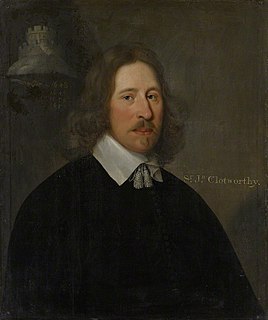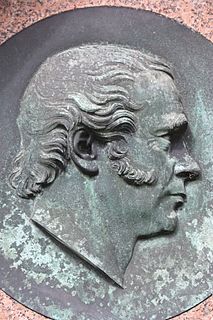Related Research Articles

Baron Lyttelton is a title that has been created one in Peerage of England and twice in Peerage of Great Britain, both times for members of the Lyttelton family. Since 1889 the title has been a subsidiary title of the viscountcy of Cobham.

Earl of Chichester is a title that has been created three times, twice in the Peerage of England and once in the Peerage of the United Kingdom. The current title was created in the Peerage of the United Kingdom in 1801 for Thomas Pelham, 2nd Baron Pelham of Stanmer.

Lord Napier, of Merchistoun, is a title in the Peerage of Scotland. It was created in 1627 for Sir Archibald Napier, 1st Baronet. Earlier that year, he already held the Napier Baronetcy, of Merchistoun in the County of Midlothian, created in the Baronetage of Nova Scotia. The titles remained united until 1683, when the Baronetcy became dormant. It was revived in the early 19th century and is now held by another branch of the Napier family. Between 1683 and 1686, the Lords of Napier also held the Nicolson Baronetcy, of Carnock in the County of Stirling, and since 1725 the Scott Baronetcy, of Thirlestane in the County of Selkirk, both baronetcies created in the Baronetage of Nova Scotia. The latter one is held till today. Additionally, the tenth Lord was created Baron Ettrick, of Ettrick in the County of Selkirk in the Peerage of the United Kingdom on 16 July 1872.

Viscount Massereene is a title in the Peerage of Ireland. It was created in 1660, along with the subsidiary title of Baron Loughneagh. From 1665 to 1816 the Skeffington Baronetcy of Fisherwick was attached to the viscountcy and from 1756 to 1816 the Viscounts also held the title of Earl of Massereene. Since 1843 the peerages are united with titles of Viscount Ferrard, of Oriel and Baron Oriel, both in the Peerage of Ireland, and Baron Oriel, in the Peerage of the United Kingdom. The Viscount also holds the subsidiary titles of Baron Loughneagh (1660) and Baron Oriel (1790) in the Peerage of Ireland and Baron Oriel (1821) in the Peerage of the United Kingdom. As Baron Oriel, he sat in the House of Lords until 1999.

Viscount Gage, of Castle Island in the County of Kerry of the Kingdom of Ireland, is a title in the Peerage of Ireland. It was created in 1720 for Thomas Gage, along with the subsidiary title of Baron Gage, of Castlebar in the County of Mayo, also in the Peerage of Ireland. In 1744 he also succeeded his cousin as eighth Baronet, of Firle Place. The titles remain united. The Gage family descends from John Gage, who was created a baronet, of Firle Place in the County of Sussex, in the Baronetage of England on 26 March 1622. His great-grandson, the seventh Baronet, represented Seaford in Parliament. He was succeeded by his first cousin, Thomas Gage, 1st Viscount Gage, the eighth Baronet. He sat as a Member of Parliament for Minehead and Tewkesbury and also served as Governor of Barbados. In 1720, 24 years before succeeding in the baronetcy, he was raised to the Peerage of Ireland as Baron Gage and Viscount Gage. His second son was the military commander the Hon. Thomas Gage.

Baron Northbourne, of Betteshanger in the County of Kent, is a title in the Peerage of the United Kingdom. It was created in 1884 for Sir Walter James, 2nd Baronet, who had earlier represented Kingston upon Hull in the House of Commons as a Conservative. His son, the second Baron, sat as a Liberal Member of Parliament for Gateshead. The latter's great-grandson, the fifth Baron, who succeeded his father in 1982, was one of the ninety elected hereditary peers that were allowed to remain in the House of Lords after the passing of the House of Lords Act 1999, and sat as a cross-bencher until his retirement in 2018. As of 2019, the titles are held by his son, the sixth baron, who succeeded his father in that year.
Baron Moncreiff, of Tulliebole in the County of Kinross, is a title in the Peerage of the United Kingdom. It was created on 9 January 1874 for the lawyer and Liberal politician Sir James Moncreiff, 1st Baronet. He had already been created a Baronet, of Kilduff in the County of Kinross, in the Baronetage of the United Kingdom on 23 May 1871. In 1883 Lord Moncreiff also succeeded his elder brother as 11th Baronet, of Moncreiff in the County of Perth. On his death the titles passed to his eldest son, the second Baron. He was a Judge of the Court of Session from 1888 to 1905 under the title of Lord Wellwood and served as Lord Lieutenant of Kinross-shire between 1901 and 1909. He was succeeded by his younger brother, the third Baron. He was a clergyman. As of 2010 the titles are held by the latter's great-grandson, the sixth Baron, who succeeded his father in 2002.

There have been three baronetcies created for persons with the surname Booth, one in the Baronetage of England and two in the Baronetage of the United Kingdom. The 1916 creation remains extant, the 1835 creation became extinct in 1896 and the 1611 baronetcy has been dormant since 1797. The senior line of the first creation was elevated to the peerage as Baron Delamer and Earl of Warrington.
James Moncreiff, 1st Baron Moncreiff of Tullibole LLD was a Scottish lawyer and politician.
Moncrieff may refer to:

Clan Moncreiffe is a Highland Scottish clan.
There have been five Baronetcies created for people with the surname Forbes, four in the Baronetage of Nova Scotia and one in the Baronetage of the United Kingdom. The first holder of the Burn Baronetcy of Jessfield, created in the Baronetage of the United Kingdom in 1923, assumed the surname of Forbes-Leith of Fyvie in 1925.

The Trollope Baronetcy, of Casewick in the County of Lincoln, is a title in the Baronetage of England. It was created on 5 February 1642 for Thomas Trollope. The seventh Baronet was a Conservative politician. In 1868 he was raised to the Peerage of the United Kingdom as Baron Kesteven, of Casewick in the County of Lincoln. The barony became extinct in 1915 when the third Baron was killed in action in the First World War. The late Baron was succeeded in the baronetcy by his cousin, the tenth Baronet.

The Parkyns Baronetcy, of Bunny Park in Nottinghamshire, is a title in the Baronetage of England. It was created on 18 May 1681 for Thomas Parkyns in acknowledgement of the royalist service of his father Colonel Isham Parkyns during the English Civil War.
There have been four baronetcies created for persons with the surname Hay, all in the Baronetage of Nova Scotia. Two creations are extinct, one dormant and one extant. A fifth baronetcy in the Jacobite Peerage, although theoretically extant, is not recognised by the Lyon Office.
The Nicolson baronets refer to one of four baronetcies created for persons with the surname Nicolson, all in the Baronetage of Nova Scotia. Two of the creations remain extant as of 2008.

Henry James Moncreiff, 2nd Baron Moncreiff was a Scottish judge who succeeded to the title Baron Moncreiff.

Sir Henry Wellwood-Moncreiff, 10th Baronet, originally Henry Moncrieff was a Scottish minister, considered one of the most influential figures in the Free Church of Scotland in his time. Henry Wellwood Moncreiff, tenth baronet, born in 1809, was ordained minister of the parish of East Kilbride, Lanarkshire, in 1836, and at the disruption, in 1843, he joined the Free Church. He was afterwards translated to St. Cuthbert's, Edinburgh. He married in 1838, Alexina-Mary, daughter of Edinburgh surgeon George Bell. He is one of the two principal clerks of the General Assembly of the Free Church of Scotland, Patrick Clason, being the other; and on the death, in 1861, of James Robertson, professor of divinity and church history in the university of Edinburgh, he was appointed his successor as secretary to her majesty's sole and only master printers in Scotland.

Sir James Wellwood Moncreiff, 9th Baronet, with the judicial title Lord Moncreiff (1776–1851) was a Scottish lawyer and judge.

Henry Moncreiff-Wellwood 8th Baronet of Tullibole FRSE was both a baronet in the Baronetage of Nova Scotia and minister of the Church of Scotland who served as Moderator of the General Assembly of the Church of Scotland in 1785. At age only 35 he was one of the youngest-ever moderators. He served as Chaplain to King George III in Scotland.
References
- 1 2 3 4 5 G. E. C., The Complete Baronetage, volume II (Exeter, 1902) p. 310.
- 1 2 3 4 5 G. E. C., Complete Baronetage, vol. II, p. 311.
- 1 2 3 G. E. C., Complete Baronetage, vol. II, p. 312.
- 1 2 Baronetcies to which no succession has been proved Archived 2011-07-09 at the Wayback Machine . Standing Council of the Baronetage. Accessed 20 July 2013.
- 1 2 3 4 5 Patrick Cracroft-Brennan, Moncreiff, Baron (UK, 1874) Archived 2010-05-25 at the Wayback Machine in Cracroft's Peerage. Accessed 20 July 2013.
- ↑ Stewart J. Brown, Wellwood, Sir Henry Moncreiff, eighth baronet (1750–1827) in Oxford Dictionary of National Biography . Accessed 20 July 2013.
- ↑ A. J. G. Mackay, rev. Michael Fry, Moncreiff, Sir James Wellwood, ninth baronet, Lord Moncreiff (1776–1851) in ODNB. Accessed 20 July 2013.
- ↑ Lionel Alexander Ritchie, Moncreiff, Sir Henry Wellwood, tenth baronet (1809–1883) in ODNB. Accessed 20 July 2013.
- 1 2 3 Gordon F. Millar, Moncreiff, James Wellwood, first Baron Moncreiff of Tulliebole (1811–1895) in ODNB. Accessed 20 July 2013.
- 1 2 3 4 G. E. C., The Complete Baronetage, volume IV (Exeter, 1904) p. 336.
- 1 2 John Burke, Burke's Peerage and Baronetage, 4th edition, volume II (1833) p. 179.
- 1 2 3 4 5 6 7 G. E. C., Complete Baronetage, vol. IV, p. 337.
- 1 2 Charles Mosley ed., Burke's Peerage, Baronetage and Knightage, 107th edition, volume I (2003) p. 1339. Cited by Darryl Lundy, thepeerage.com, p. 27858. Accessed 20 July 2013.
- ↑ The Times, 18 November 1957. Cited by Leigh Rayment, Baronets - Meyer to Moody [Usurped!]. Accessed 20 July 2013.
- 1 2 3 Alan Bell, Moncreiffe, Sir (Rupert) Iain Kay, of that ilk, eleventh baronet (1919–1985) in ODNB. Accessed 20 July 2013.
- 1 2 Patrick Cracroft-Brennan, Erroll, Earl of (S, 1452) in Cracroft's Peerage. Accessed 20 July 2013.